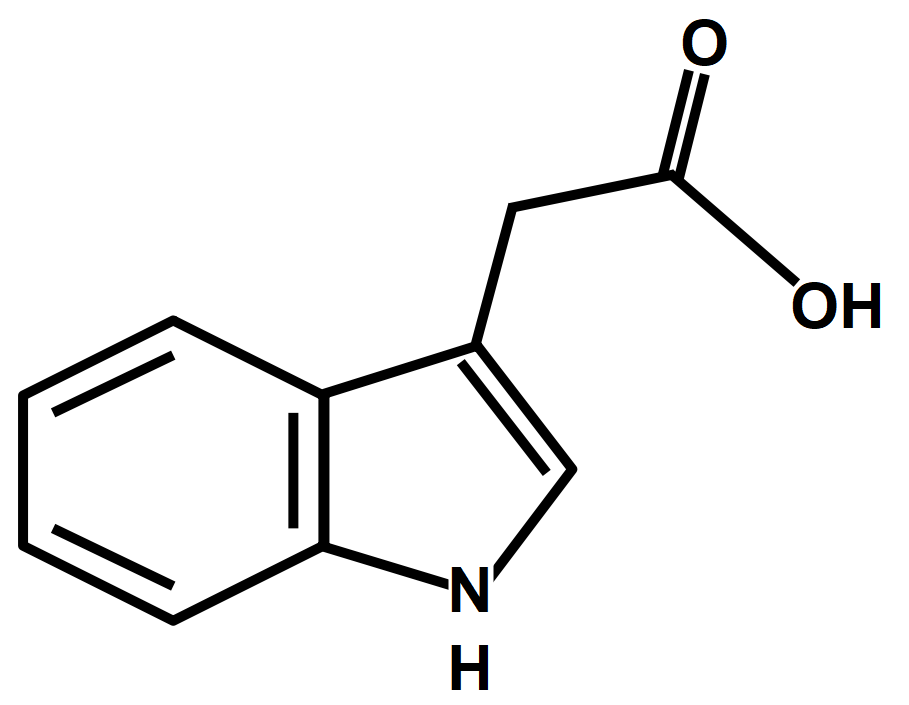
What is the chemical name of auxin?


Answer
406.8k+ views
Hint: We know that the auxin word is taken from the Greek word auxein, which means to grow. Auxins were first isolated from human urine. The term auxin is applied to the \[indole-3-acetic\] acid (IAA), and to other natural and synthetic compounds having certain growth-regulating properties.
Complete answer:
As we know that the Auxins are a powerful growth hormone produced naturally by the plant. They are seen in the shoot and the root tips and promote cell division, stem and root growth. Auxins are the plant hormones that are produced naturally by plants. When sun rays fall on the plant the auxin helps in growth of the plant. Auxins can also be manufactured artificially. Such auxins are known as synthetic auxins. Auxins promote elongation of the stem. Auxins stimulate gibberellins which results in elongation of cells. This increases the length of the plant. Auxins along with gibberellins are responsible for increasing the distance between nodes.
Auxins control the growth of seedlings by controlling the growth of cells. Auxins are affected by light and they have the tendency to concentrate in plant parts that are away from the light. More growth of cells occurs in those parts of the plant which show high concentration of auxins. As auxins are found in more concentration in the shaded side of the plant, the shaded side of the plant shows more growth than parts exposed to light. An example of artificially synthesized Auxin is \[2,4-\] dichloro phenoxy acetic acid.
Note:
Remember that the natural auxins are produced by plants, while synthetic auxins are prepared in laboratories. Both natural and synthetic auxins perform various functions in plants such as elongation of stem, branching of roots, development of fruit, and growth of seedlings.
Complete answer:
As we know that the Auxins are a powerful growth hormone produced naturally by the plant. They are seen in the shoot and the root tips and promote cell division, stem and root growth. Auxins are the plant hormones that are produced naturally by plants. When sun rays fall on the plant the auxin helps in growth of the plant. Auxins can also be manufactured artificially. Such auxins are known as synthetic auxins. Auxins promote elongation of the stem. Auxins stimulate gibberellins which results in elongation of cells. This increases the length of the plant. Auxins along with gibberellins are responsible for increasing the distance between nodes.
Auxins control the growth of seedlings by controlling the growth of cells. Auxins are affected by light and they have the tendency to concentrate in plant parts that are away from the light. More growth of cells occurs in those parts of the plant which show high concentration of auxins. As auxins are found in more concentration in the shaded side of the plant, the shaded side of the plant shows more growth than parts exposed to light. An example of artificially synthesized Auxin is \[2,4-\] dichloro phenoxy acetic acid.
Note:
Remember that the natural auxins are produced by plants, while synthetic auxins are prepared in laboratories. Both natural and synthetic auxins perform various functions in plants such as elongation of stem, branching of roots, development of fruit, and growth of seedlings.
Recently Updated Pages
The correct geometry and hybridization for XeF4 are class 11 chemistry CBSE

Water softening by Clarks process uses ACalcium bicarbonate class 11 chemistry CBSE

With reference to graphite and diamond which of the class 11 chemistry CBSE

A certain household has consumed 250 units of energy class 11 physics CBSE

The lightest metal known is A beryllium B lithium C class 11 chemistry CBSE

What is the formula mass of the iodine molecule class 11 chemistry CBSE

Trending doubts
Describe the effects of the Second World War class 11 social science CBSE

Which of the following methods is suitable for preventing class 11 chemistry CBSE

Proton was discovered by A Thomson B Rutherford C Chadwick class 11 chemistry CBSE

Why do you think did the narrator call lie Amsterdam class 11 english CBSE

Tentacles of Hydra are A Hollow B Solid C Half hollow class 11 biology CBSE

What do you mean by public facilities




